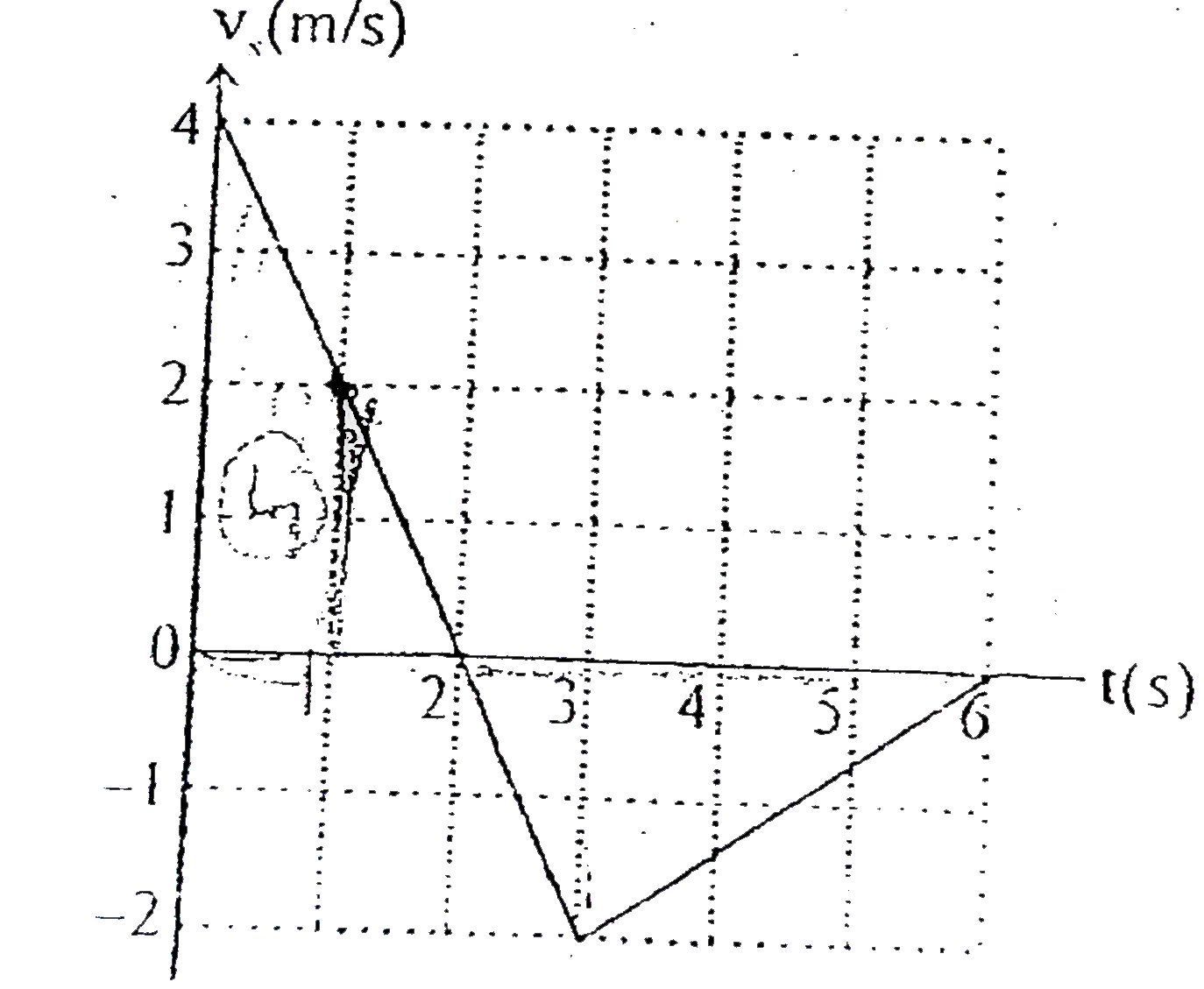The initial position and velocity of a body moving in SHM with period T=0.25s are x=5.0cm and v=218cm/s. What are the amplitude and phase constant of the motion ?
The correct Answer is:A, C, D
To solve the problem of finding the amplitude and phase constant of a body moving in Simple Harmonic Motion (SHM) with given initial conditions, we can follow these steps:
Step 1: Calculate Angular Frequency (ω)
The angular frequency ω can be calculated using the formula:
ω=2πT
Given that the period T=0.25s:
ω=2π0.25=8πrad/s
Step 2: Set Up the Equations
The general equations for position x and velocity v in SHM are:
x=Asin(ωt+ϕ)
v=ωAcos(ωt+ϕ)
At time t=0, we can simplify these equations to:
x(0)=Asin(ϕ)(1)
v(0)=ωAcos(ϕ)(2)
Step 3: Substitute Known Values
From the problem, we know:
- x(0)=5.0cm
- v(0)=218cm/s
- ω=8πrad/s
Substituting these values into equations (1) and (2):
1. 5.0=Asin(ϕ) (Equation 1)
2. 218=8πAcos(ϕ) (Equation 2)
Step 4: Solve the Equations
From Equation (1):
Asin(ϕ)=5.0⇒A=5.0sin(ϕ)(3)
Substituting Equation (3) into Equation (2):
218=8π(5.0sin(ϕ))cos(ϕ)
218sin(ϕ)=40πcos(ϕ)
Dividing both sides by cos(ϕ):
218sin(ϕ)cos(ϕ)=40π
This simplifies to:
218tan(ϕ)=40π
tan(ϕ)=40π218
Step 5: Calculate Phase Constant (φ)
Now we can find ϕ:
ϕ=tan−1(40π218)
Calculating this gives:
ϕ≈π6 or 30∘
Step 6: Calculate Amplitude (A)
Now substituting ϕ back into Equation (3) to find A:
A=5.0sin(π6)=5.00.5=10.0cm
Final Answers
- Amplitude A≈10.0cm
- Phase constant ϕ≈π6 or 30∘
The angular frequency ω can be calculated using the formula:
ω=2πT
Given that the period T=0.25s:
ω=2π0.25=8πrad/s
The general equations for position x and velocity v in SHM are:
x=Asin(ωt+ϕ)
v=ωAcos(ωt+ϕ)
At time t=0, we can simplify these equations to:
x(0)=Asin(ϕ)(1)
v(0)=ωAcos(ϕ)(2)
From the problem, we know:
- x(0)=5.0cm
- v(0)=218cm/s
- ω=8πrad/s
1. 5.0=Asin(ϕ) (Equation 1)
2. 218=8πAcos(ϕ) (Equation 2)
From Equation (1):
Asin(ϕ)=5.0⇒A=5.0sin(ϕ)(3)
218=8π(5.0sin(ϕ))cos(ϕ)
218sin(ϕ)=40πcos(ϕ)
Dividing both sides by cos(ϕ):
218sin(ϕ)cos(ϕ)=40π
This simplifies to:
218tan(ϕ)=40π
tan(ϕ)=40π218
Now we can find ϕ:
ϕ=tan−1(40π218)
Calculating this gives:
ϕ≈π6 or 30∘
Now substituting ϕ back into Equation (3) to find A:
A=5.0sin(π6)=5.00.5=10.0cm
- Amplitude A≈10.0cm
- Phase constant ϕ≈π6 or 30∘
Topper's Solved these Questions
- SIMPLE HARMONIC MOTIONBook:DC PANDEY ENGLISHChapter:SIMPLE HARMONIC MOTIONExercise:Level 2 Single Correct
Explore 28 Videos
- SIMPLE HARMONIC MOTIONBook:DC PANDEY ENGLISHChapter:SIMPLE HARMONIC MOTIONExercise:Level 2 More Than One Correct
Explore 8 Videos
- SIMPLE HARMONIC MOTIONBook:DC PANDEY ENGLISHChapter:SIMPLE HARMONIC MOTIONExercise:Level 1 Single Correct
Explore 24 Videos
- SEMICONDUCTORS AND ELECTRONIC DEVICESBook:DC PANDEY ENGLISHChapter:SEMICONDUCTORS AND ELECTRONIC DEVICESExercise:More than One Option is Correct
Explore 3 Videos
- SOLVD PAPERS 2017 NEET, AIIMS & JIPMERBook:DC PANDEY ENGLISHChapter:SOLVD PAPERS 2017 NEET, AIIMS & JIPMERExercise:Solved paper 2018(JIPMER)
Explore 38 Videos
Similar Questions
The position and velocity of a particle executing simple harmonic motion at t = 0 are given by 3 cm and 8cms−1 respectively . If the angular frequency of the particle is 2rad s−1 , then the amplitude of oscillation (in cm) is
View SolutionThe motion of a particle in S.H.M. is described by the displacement function, x=Acos(ωt+ϕ), If the initial (t=0) position of the particle is 1cm and its initial velocity is ωcms−1, what are its amplitude and initial phase angle ? The angular frequency of the particle is πs−1. If instead of the cosine function, we choose the sine function to describe the SHM:x=Bsin(ωt+α), what are the amplitude and initial phase of the particle with the above initial conditions ?
View Solution
Knowledge Check
The position of an object moving along x-axis is given by x=a+bt2, where a=8.5m and b=2.5 ms^(-2) and (t) is measured in seconds. What is the velocity at t=1= 0sandt=2.0 s? What is the average velocity between t=2.0s and t=4.0s? a) 5 m/s b) 10 m/s c) 15 m/s d) 20 m/s
A5ms−1B10ms−1C15ms−1D20ms−1
a−x equation of a body in SHM is a+16x=0. Here, x is in cm and a in cm/s2. Find time period of oscillations.
View SolutionA particle executing SHM with time period of 2s: Find the time taken by it to move from one amplitude to half the amplitude position.
View SolutionA particle having mass 10 g oscillates according to the equation x=(2.0cm)sin[(100s−1)t+π6]. Find a the amplitude the time period and the spring constant b. the position, the velocity and the acceleration at t=0.
View SolutionA particle is subjected to two simple harmonic motions of same time period in the same direction. The amplitude of the first motion is 3.0 cm and that of the second is 4.0 cm. Find the resultant amplitude if the phase difference between the motion is a. 0∘,b.60∘,c.90∘
View SolutionA body is in simple harmonic motion with time period T = 0.5 s and amplitude A = 1 cm. Find the average velocity in the interval in which it moves from equilibrium position to half of its amplitude.
View SolutionThe velocity of a particle in S.H.M. at positions x1 and x2 are v1 and v2 respectively. Determine value of time period and amplitude.
View SolutionVx is the velocity of a particle of a particle moving along the x−axis as shown. If x=2.0m at t=1.0s, what is the position of the particle at t=6.0s?

View Solution